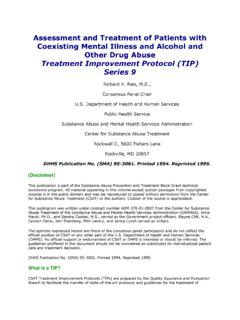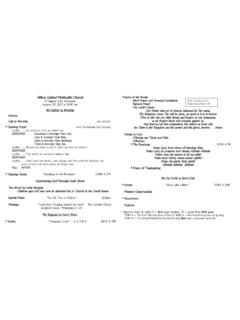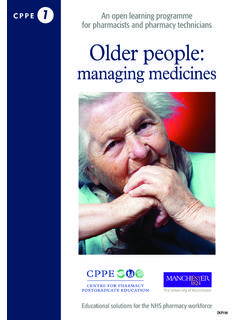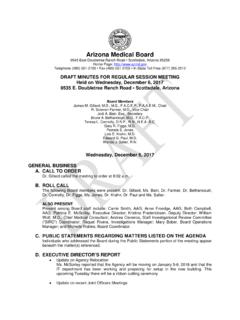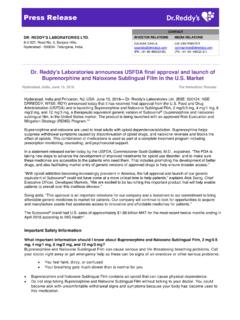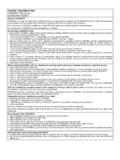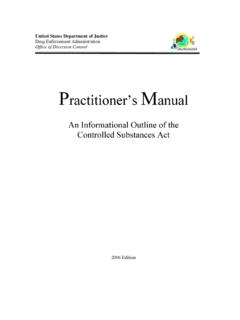Transcription of Classifying Skin Lesions of Injection Drug Users
1 Center for Substance Abuse Treatment Classifying skin Lesions of Injection Drug Users A Method for Corroborating Disease Risk DEPARTMENT OF HEALTH AND HUMAN SERVICES Substance Abuse and Mental Health Services Administration Center for Substance Abuse Treatment Center for Substance Abuse Treatment The purpose of these photocards is to illustrate a classification system to identify the appearance of skin Lesions on Injection drug Users . Injection drug use often is associated with increased risk for HIV and hepatitis B and C infection. For those working in the health care and substance abuse fields, having the ability to distinguish drug Injection Lesions ( , needle track marks) from Lesions attributable to other factors may help facilitate accurate diagnoses and promote the delivery of effective treatments and interventions to reduce patient risk.
2 All material in these photocards is in the public domain and may be reproduced or copied without permission from the Substance Abuse and Mental Health Services Administration (SAMHSA) or the Center for Substance Abuse Treatment (CSAT). However, this publication may not be reproduced or distributed for a fee without the specific, written authorization of the Office of Communications, SAMHSA, Department of Health and Human Services. Citation of the source is appreciated. The recommended citation is: Cagle, ; Fisher, ; Senter, ; Thurmond, ; and Kastar, Classifying skin Lesions of Injection Drug Users : A Method for Corroborating Disease Risk. DHHS Pub. No. (SMA) 02-XXX. Rockville, MD: Center for Substance Abuse Treatment, Substance Abuse and Mental Health Services Administration, 2002.
3 These photocards are based on a photo classification system developed during a research project (for details, see the back of these photocards). The photocards were written under contract number 270-95-0013 by Johnson, Bassin & Shaw, Inc. (JBS). Ray Hylton, Jr., , , and Alan Trachtenberg, , served as the CSAT government project officers. Center for Substance Abuse Treatment Classifications 1 Recent/Old: Lesions appear to be recent ( , inflammation, infection, or nonhealed puncture wounds) and are paired with older evidence, such as scars, old granulomas, and atrophy or pigment changes at multiple locations. Hispanic/Latino, Left Hand. Old Lesions consist of scars, post-inflammatory linear and nonlinear changes in pigmentation, and skin atrophy (note shiny skin ).
4 New Lesions consist of healing with fresh eschar (scabs). Caucasian, Right Hand. Old Lesions consist mainly of post-inflammatory linear changes in pigmentation. New Lesions consist of nonhealed puncture wounds with accompanying acute inflammatory changes. Center for Substance Abuse Treatment Classifications 2 Recent Only: Lesions appear to be recent ( scabs, punctures, acute or subacute inflammations, thrombosis with wounds, abscesses, or granulomas). Alaska Native, Right Forearm. New Lesions consist of fresh linear skin punctures with accompanying fresh eschar (scabs). Caucasian, Neck. New Lesions consist of recent puncture wounds with accompanying subacute inflammation. Center for Substance Abuse Treatment Classifications 3 Old Only: lesion characteristics include scars, atrophy, hyper- or hypo-pigmentation, pigmented granulomas, or noninflamed thrombosis.
5 Hispanic/Latino, Left Forearm. Old Lesions consist of punctate scars (tiny spots or prick marks) with post-inflammatory pigmentary changes that are both linear and nonlinear. African American, Right Forearm. Old lesion consists of scarring with accompanying atrophy of the surrounding tissues and slight pigmentary changes. Center for Substance Abuse Treatment Classifications 4 Conflictive: lesion characteristics are indiscernible. Caucasian, Left Forearm. This single inflammatory lesion represents what may be folliculitis (an inflammation of hair follicles), an insect bite, or some other condition or wound. 5 Unsure: Specific nature of lesion is difficult to determine. American Indian, Left Forearm. Lesions are subtle, unremarkable, and defy a good description, based upon evidence presented.
6 Center for Substance Abuse Treatment Classifications 6 Inconsistent: lesion may not be or probably is not an Injection site; evidence is insufficient. Alaska Native, Left Forearm. Lesions are subtle; slight pigmentary changes may or may not be consistent with Injection drug use. African American, Right Forearm. Lesions are subtle; puncture wound may or may not be consistent with Injection drug use. Note: Classification levels 4, 5, and 6 are similar enough that, in practice, they could collectively be considered as a singular classification labeled as Indeterminate or Unsure. Center for Substance Abuse Treatment About This Photo Classification System .. Method: Research staff at the University of Alaska, Anchorage, were trained to photograph Lesions on the skin of Injection drug Users by a registered biological photographer.
7 Staff then photographed Lesions of 282 subjects who had given informed consent. Based on these photographs, a practicing dermatologist, independent of research staff, developed a six-level classification system that categorized lesion characteristics according to their consistency with Injection drug use. The accuracy of this proposed classification scheme was then tested by two additional expert raters, who used the system to rate the photographs independently. Using Cohen s kappa coefficient, agreement between the two independent raters was .64 (95 percent confidence interval of .55 to .73). (Cohen s kappa is used to test whether agreement between two raters exceeds chance. A value of 0 indicates that agreement is no better than chance.)
8 Sample subjects: Participants were at least 18 years old; had positive urinalysis for cocaine metabolites, morphine, and/or amphetamines; self-reported Injection drug use; and presented skin Lesions suggesting a history of Injection drug use. Researchers gave participants the NIDA Risk Behavior Assessment (RBA) Questionnaire, tested and counseled them about the human immunodeficiency virus (HIV) and hepatitis, and paid for their time in research. The study compared behavior reported on the RBA with evidence of Lesions in the photographs. Findings: Recent Injection sites (classifications 1 and 2 only) were associated with both an increased frequency of 30-day opiate Injection and with the number of times a new, never-used needle/syringe was usually reused before disposal.
9 This photo classification system was developed by Henry H Cagle, Dennis G. Fisher, , Thomas P. Senter, , Roger D. Thurmond, , and Alden J. Kastar while working on the IVDU Project, Department of Psychology, University of Alaska, Anchorage. The research project was funded in part by R01 DA10181 from the National Institute on Drug Abuse (NIDA). For additional details, contact Dennis G. Fisher, , Director, Center for Behavioral Research and Services, 1090 Atlantic Avenue, Long Beach, CA 90813 Substance Abuse and Mental Health Services Administration (SAMHSA) For additional copies, contact SAMHSA s National Clearinghouse for Alcohol and Drug Information (NCADI), (800) 729-6686 or (301) 468-2600; TTD (for hearing impaired), (800) 487-4889; or visit NCADI Order No.
10 AVD154 DHHS Publication No. (SMA) 02-3753 Printed 2002
